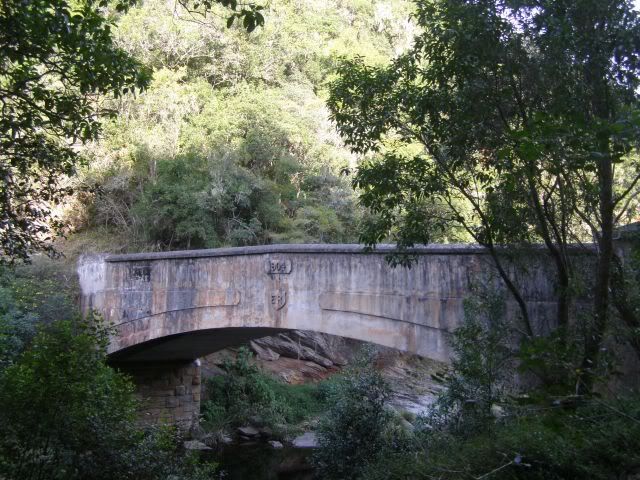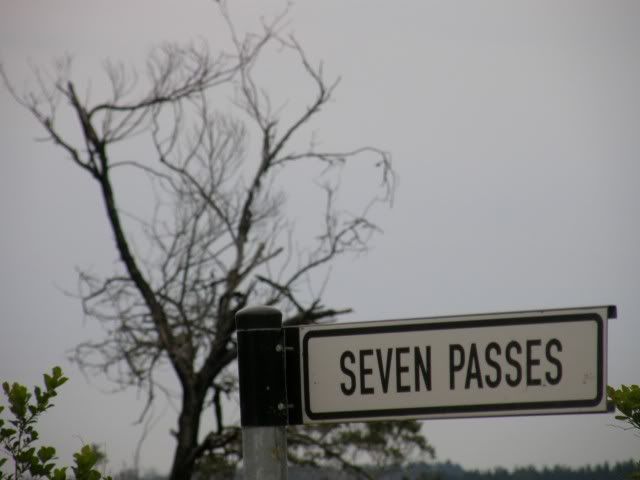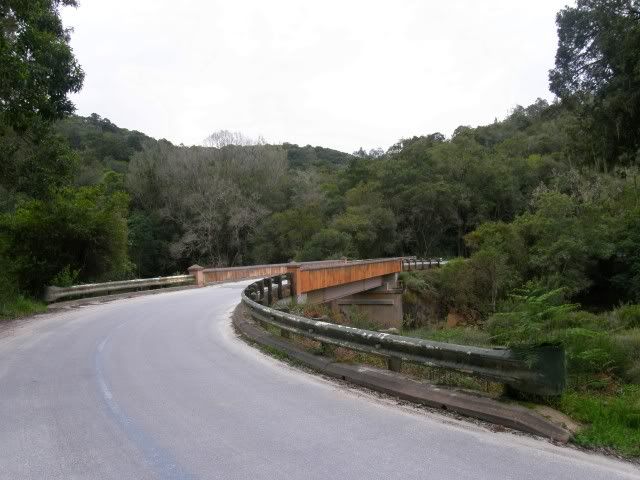Our weekend ride was over, but Trailblazer still had a long way to go on his 3 week holiday. I joined him on the 7 Passes road and all the way to the Kom-se-Pad turnoff which could be tricky to find. This a special route and it was a honour to show him around one last day.
According to the definition a "Pass" is a road crossing a natural barrier, usually a mountain, but it could also be a river or a gorge. The passes of the Seven passes road crosses rivers and the Homtini Gorge.
This 75 kilometer road was completed in 1883. Before this road was built, travel between George and Knysna was by no means easy. Andrew Geddes Bain, when wanting to describe just how horrible a certain pass was, said: "the fearful ruggedness outstrips even that between George and Knysna, and that is saying enough..."
The passes road was built over a period of 16 years and and the construction of the 75 kilometers was very fragmented, with bits being done here and there as was most convenient and economical.

In 1867 the project of building the road got the green light and Adam de Smidt comenced construction from George. By 1869 De Smidt reached the Kaaimans & Silver River gorges (the first two passes of the seven, travelling East) and the work here was only eventually completed in 1875.
In 1903 & 1904 respectively the timber bridges over the Kaaiman's and Silver rivers were replaced by stone bridges. The section of road closest to George was tarred and used as an alternative route to the N2 while that road was upgraded. It's amazing to think that this small road was the main route between Knysna & George in modern times.
The Kaaimans Bridge (1904):


The Silver River Bridge (1903):


Climbing to the plateau behind Wilderness Heights the tar road ends and you hit the first gravel.

The 3rd pass takes you over the Touw River. This pass and rest of the passes are all gravel (although the roads in between are tarred intermittently), but where the bridges actually cross the river there are short sections of tar either side of the bridge.
The Touw River Bridge is the last surviving iron bridge on the old road between George and Knysna. The ironwork of the 95ft clear span was built in 1897 by Messrs Braithwaite and co. of West Bromwich, England and shipped out to Mossel Bay. It was then conveyed in fourteen wagon loads to the site over two months. The estimated cost of the ironwork was 3850 Pounds and the approximate weight of the entire bridge was 57 English Tons. The completed bridge was opened for transport in 1898.

Hoogekraal Pass is the fourth pass on this route. It's very similar (though smaller) to the Touw river pass but has a more modern bridge.



Karatara Pass (5th): The first nugget of gold was found in the Karatara river bed in 1875. This find, along with the finds at Millwood had an influence on this route, causing it to be built closer to the mountains.

Homtini pass (6th) is my personal favourite of the seven passes. It crosses the dreaded Homtini gorge and this pass was a major construction feat, with the road curdling down two and a half kilometers to the bottom of the gorge and up the other side, through dense indigenous forest.
Bulpin describes the pass as "a classic piece of old time road making with dramatic views and the indefinable elegance of its curves."
This most attractive pass was in effect completed in 1882, but was only available for traffic the following year.



And finally Phantom Pass. The construction of the passes road continued to join the Phantom Pass near Knysna. Phantom Pass was named, it is said, after the white Phantom Moth found in the area. This road was the first bit of the Passes road to be built (by Bain), but it was upgraded in 1882 when it was required to carry through traffic.

The passes road was completed in 1883, sixteen years after work commenced on it. It was the main road between George and Knysna for almost 70 years, until the National Road was completed in 1952, and still serves the area through which it passes.
By now the weather was moving in and it seemed like I could expect some rain on the way back to George. The Knysna Heads:

I escorted Trailblazer to the turnoff to Gouna and we said our goodbyes. I envied him as he rode off towards Kom-se-Pad and Baviaans.

Safe travels my friend.
I did not want my ride to be over yet, so I decided to head to George along the N2 and stop along the way at every beach, but as soon as I hit the N2 the first drops started falling so I hightailed it home.
Riding past Buffelsbay and Sedgefield I realized I was going to get wet either way so I stopped near Wilderness to admire the view:

and again at Wilderness Beach:


The spot where the Kaaimans river flows into the ocean is the site of another historic bridge. This is where the railway line between George and Knysna crosses the river. The Kaaimans River Bridge is known as an excellent spot for taking photographs of the scenery and the Outeniqua Tjoe-Choo as it passed over the ocean on its journey between George and Knysna.

In 1922 the Railways and Harbours Board recommended the construction of a railway between George and Knysna, a distance of approximately 67 kilometers, at an estimated cost of 296 820 pounds. The building of the line was started simultaneously from George and Knysna in 1924. Although the railway from George to Knysna was available for goods and passenger traffic since May 1928, it was formally opened by the Minister of Railways and Harbours, the Hon. C. W. Malan, on Wednesday, October 17th. When this line was built it was regarded as the most expensive piece of clickety clack in the world. Today it is billed as the most beautiful.
The line travels through two tunnels of moderate length, cut into the hills above the sea, before it approaches the Kaaimans River Bridge, 210 meters long and 36 meters high.
Sadly the railway line was badly damaged in the floods of 2006 and the train has not run since. It is unsure if it ever will again


I rode down the new Kaaimans Pass and stopped at this causeway (just off the N2) next to the Kaaimans River.

By now it was well and truly raining and I was drenched

but happy.
Trailblazer it was good to ride with you and even better to make a new friend. See you again next year.

My route today:

The source most used in this ride report (sometimes quoted verbatim) is "The Romance of Cape Mountain Passes" written by Graham Ross.

It is an excellent resource, well written and I highly recommend buying this book if you plan to ride the passes of the Cape provinces. Every Dual Sport rider should have one! 
